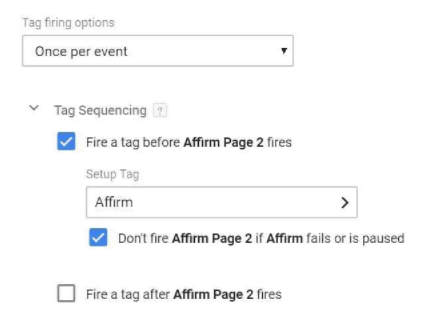About Google Tag Manager
Learn about using a tag management solution to manage tracking, advertising, and other marketing functions on your site.
Overview
You can use a tag manager to dynamically inject Affirm-related scripts on the promotions.
Embed the Affirm payment method option onto your existing checkout page using Google Tag Manager exclusively.
About Google Tag Manager
Google Tag Manager includes a feature to sequence tag execution so that you can make sure Affirm-JS is always loaded first.
With Google Tag Manager, you can set up and manage tags on your site without changing your site's code.
Promos
Here is an example of how that would be setup:
| Tag # | Contents | Location | Trigger |
|---|---|---|---|
| Tag 1 | Affirm JS embed code | All pages | Page load (auto) |
| Tag 2 | Affirm promo html | Only pages where promotional messaging should display | Fires after 'Tag 1' |
Below is a screenshot of how these settings look in Google Tag Manager:

Checkout
| Tag # | Contents | Location | Trigger |
|---|---|---|---|
| Tag 1 | Affirm JS embed code | All pages | Page load (auto) |
| Tag 2 | Affirm promo html | Only pages where promotional messaging should display | Fires after 'Tag 1' |
Updated 8 days ago